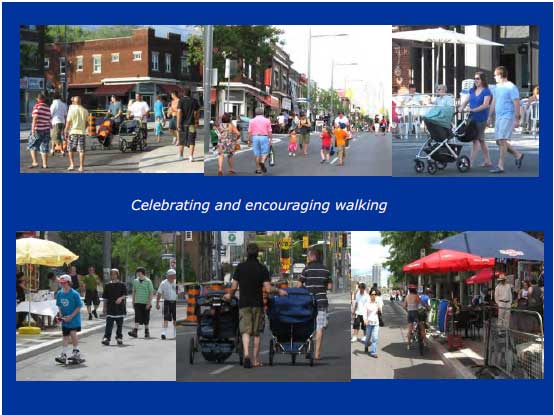Getting around Toronto (Ontario, Canada) everyday by walking would be wonderful for improving our well-being, personal budget, Toronto’s environment, and clean air by reducing:
- pollution and congestion,
- greenhouse gas (GHG) emission,
- the city’s infrastructure and road maintenance costs
- the use of gasoline-fueled vehicles, and
- transportation expense due to the ever-increasing cost of gasoline for personal vehicles
Also, the city “aims to strengthen Torontonians’ sense of community by putting more “eyes on the street’ and by creating more shared public spaces and opportunities for social interaction and recreation.”
Walk safely and comfortably in Toronto communities via City of Toronto Walking Strategy is part of the city’s goal “to transform its streets, public spaces and neighborhoods into a great walking city, and to integrate these spaces with public transit, cycling and other sustainable modes of travel.”

With the focus on walk more and drive less, the City of Toronto Walking Strategy is this year’s winner of the Federation of Canadian Municipalities (FCM), which produces proactive initiatives as follows:
- The city is pilot testing pedestrian-only streets, intersections featuring “No Right Turns on Red,” intersections with leading pedestrian interval signals, and has already added a number of pedestrian priority intersections (scramble intersections) wherein pedestrians are “dancing in the streets” at some intersections in Toronto
- Please click here for a new searchable “walks” database website that enables you to plan your walking routes, given the choices of 26 self-guided walking tours of some of the city’s most beautiful and interesting areas
- Regulatory and operational changes to accommodate timed pedestrian-only areas support Pedestrian Sundays in Kensington Market
- Building a more walkable Toronto will contribute significantly toward achieving the city’s Climate Change, Clean Air and Sustainable Energy Action Plan GHG emission reduction targets of six per cent by 2012, 30 per cent by 2020 and 80 per cent by 2050
- A 2008 study among those working downtown found that 58 per cent walked to work, up from 44 per cent; cycling doubled, from two to four per cent; and only six per cent of downtown residents drove to work, down from 16 per cent, all in comparison to 2001 figures
Also, Toronto is inviting you to create a customized self-guided walking tour. There are a limited number of grants up to $500 a year that are available to cover the costs of producing such a tour.
The following organizations and individuals are eligible to participate:
• not-for-profit organizations
• Grade 1 to Grade 12 students
• college and university students
• individuals or a group of friends interested in walking.
Preference will be given to self-guided walking tours that meet one of the following objectives:
• located in a neighbourhood not currently represented in the database
• innovative and fun
• focused on health and well-being.
Kudos to Toronto!
Toronto, Ontario, Canada
News Release
May 4, 2011
New City of Toronto website features self-guided walking tours
The City of Toronto has created a website where residents and visitors to Toronto can get information about 26 self-guided walking tours of some of the city’s most beautiful and interesting areas.
A self-guided tour is a walking tour without a guide, a fee, or a set date or time. It is an opportunity for individuals or groups to explore the city at their own pace while learning about their surroundings.
“Walking is a great way to get around the city and this website is a terrific resource where the public can go to select areas of the city they wish to explore on foot,” said Councillor Minnan-Wong (Ward 34 Don Valley East), Chair of the City’s Public Works and Infrastructure Committee.
In addition to the walking tours currently posted, the City is offering organizations and individuals the opportunity to create a customized self-guided walking tour. There are a limited number of grants up to $500 a year that are available to cover the costs of producing such a tour.
The following organizations and individuals are eligible to participate:
• not-for-profit organizations
• Grade 1 to Grade 12 students
• college and university students
• individuals or a group of friends interested in walking.
Preference will be given to self-guided walking tours that meet one of the following objectives:
• located in a neighbourhood not currently represented in the database
• innovative and fun
• focused on health and well-being.
More information about the program is available at http://www.toronto.ca/transportation/walking.
The City has many guidelines, programs and projects that focus on improving pedestrian environments and fostering a culture of walking, such as, the pedestrian priority intersections (scramble intersections), Discovery Walks, Walk into Health program, pedestrian countdown signals and the Live Green initiative.
Toronto is Canada’s largest city and sixth largest government, and home to a diverse population of about 2.6 million people. Toronto’s government is dedicated to delivering customer service excellence, creating a transparent and accountable government, reducing the size and cost of government and building a transportation city. For information on non-emergency City services and programs, Toronto residents, businesses and visitors can dial 311, 24 hours a day, 7 days a week.
———————————————————————
Happy Walking!
You may also like:
Blue BIXI Bikes Will Brighten Toronto Streets on May 3
